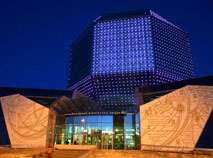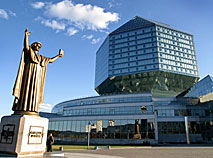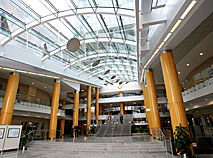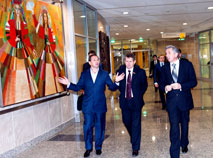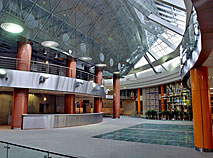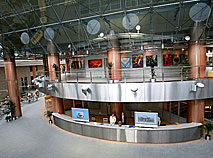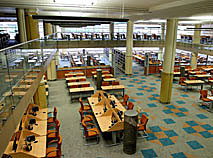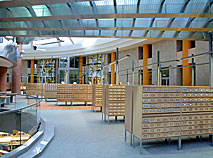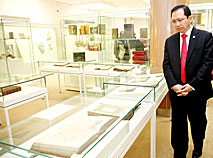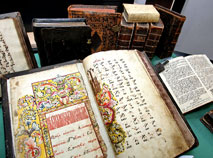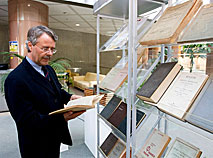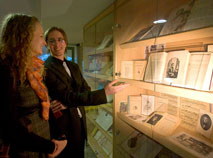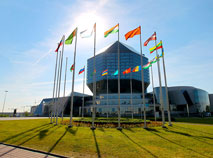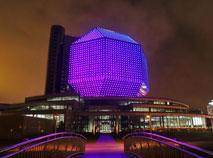National Library of Belarus
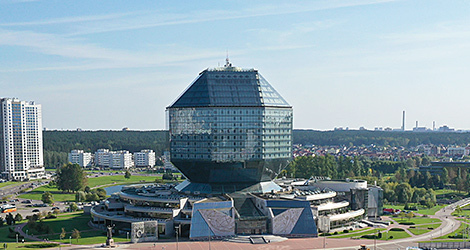
The National Library is an attractive landmark of Belarus. Today the library is more than a rich collection of books. It is a multipurpose center that combines high technologies, ultramodern design and unusual architecture.
National Library history
The country’s top library was founded in 1922 under the aegis of the Belarusian State University. Back then it was named the Belarusian State and University Library. Initially it contained 60,000 books.
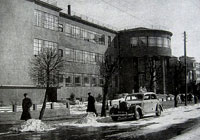 In 1926 the Belarusian State Library became an independent institution. The decision to build new premises for it was made then.
In 1926 the Belarusian State Library became an independent institution. The decision to build new premises for it was made then.
Well-known Belarusian architect Georgy Lavrov came up with an unusual design that embodies a mathematical system of coordinates. Today the building is one of the few remaining specimens of the constructivism age in Belarus and home to the Council of the Republic of the National Assembly.
During the Great Patriotic War the Belarusian State Library named after Lenin lost about 83% of its books and special equipment. It managed to evacuate all the rare and early printed books, editions stored in the circulation department and reading halls while the reserve fund building burnt down completely together with what was inside.
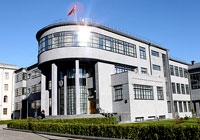 After the war the library was reborn and developed, collecting more books and establishing international ties.
After the war the library was reborn and developed, collecting more books and establishing international ties.
In 1992 as part of the sovereign state it was renamed into the National Library of Belarus.
With time its collections grew much larger, necessitating the construction of new, larger, and modern premises.
Design of the new library building
In 1989 a USSR-wide contest was held to choose the best architectural design for the Library. The winners – architects Viktor Kramarenko and Mikhail Vinogradov – suggested the Belarusian diamond design that combines functionality and modern design solutions.
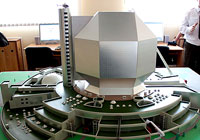 The design envisaged the construction of an original building in the shape of a rhombicuboctahedron — a complex polyhedron of 18 squares and 8 triangles resting on a supporting podium (stylobate). The surface of the diamond is covered by glass.
The design envisaged the construction of an original building in the shape of a rhombicuboctahedron — a complex polyhedron of 18 squares and 8 triangles resting on a supporting podium (stylobate). The surface of the diamond is covered by glass.
The authors wanted the cut diamond shape to symbolize the value of knowledge and the endlessness of the perceptible world.
Nevertheless, it took 13 years to get the daring design approved and implemented.
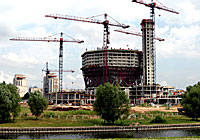 The large-scale construction project, which involved about 5,000 people and 200 enterprises, began in 2002. At peak times up to 3,000 people worked at the site every day 24 hours a day.
The large-scale construction project, which involved about 5,000 people and 200 enterprises, began in 2002. At peak times up to 3,000 people worked at the site every day 24 hours a day.
The National Library of Belarus was opened by the Belarus President on 16 June 2006.
The National Library is located in the park zone of the Slepyanka River and greenery system. A bronze sculpture of the printing pioneer Frantsisk Skorina (by Aleksandr Dranets and Viktor Kramarenko) has been placed in front of the building.
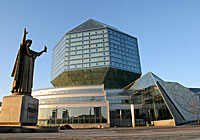 The central entrance looks like an open book with pictures to highlight the development of the global written language and the Slavonic one as well as a quote in 19 languages from Frantsisk Skorina’s Bible that encourages people to learn.
The central entrance looks like an open book with pictures to highlight the development of the global written language and the Slavonic one as well as a quote in 19 languages from Frantsisk Skorina’s Bible that encourages people to learn.
The Library’s interior uses works by modern Belarusian artists and sculptors for decoration.
The authors of the National Library design and other famous buildings are Viktor Kramarenko and Mikhail Vinogradov. They have been awarded the state prizes of the Republic of Belarus twice.
National Library of Belarus today
The country’s top library is now an information, research, sociocultural, and sociopolitical center.
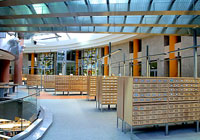 Professor Roman Motulsky, Doctor of Pedagogy is the Director of the Library.
Professor Roman Motulsky, Doctor of Pedagogy is the Director of the Library.
The collection of the "diamond of knowledge" contains about 9 million editions on various media. Those are printed editions, manuscripts, microcopies, digital materials and other materials created in Belarus and abroad in over 80 languages.
Visitors are welcome to use versatile information resources and collections of the Library:
-
manuscripts, early printed books (over 70,000)
-
newspapers (about 4,700 titles)
-
magazines and ongoing publications (over 3 million copies from the early 19th century and up to the present day)
-
graphic documents
-
printed music
-
audiovisual documents
-
compact disks
-
maps
-
thesis papers and autoabstracts of thesis papers
-
digital information resources (access to over 150 national and foreign databases)
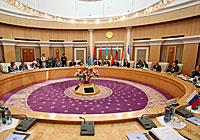 The main part of the collections is located on ten floors of the storage facility. Over 500,000 copies are available for public access and in reading halls. Digital resources can be accessed via computers in the Library while some are available via the Internet.
The main part of the collections is located on ten floors of the storage facility. Over 500,000 copies are available for public access and in reading halls. Digital resources can be accessed via computers in the Library while some are available via the Internet.
Following the relevant instruction of the Belarus President a center for international meetings and negotiations at the level of heads of state and heads of government was set up in the Library in 2005.
The center boasts multifunctional modern equipment and special communication solutions and allows hosting top political, cultural, and educational events. So far it has been used for:
-
several summits of the CIS states at the level of heads of government and heads of state
-
sessions of the EurAsEC Interstate Council
-
international forums and scientific conferences (the 10th session of the International Assembly of Capitals and Cities, the international congress National Library as a Cultural Phenomenon, the 15th international congress of Slavists)
-
press conferences of the Belarus President (for representatives of Russian regional mass media, representatives of Belarusian and foreign media)
The guests of honors of the National Library include heads of state, heads of government, heads of parliaments, heads of international organizations, prominent scientists, writers, and painters.
The sociocultural center of the Library hosts: 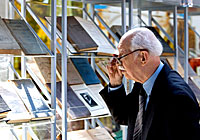
-
national and international painting exhibitions, festivals and private viewings (Dedicated to Belarus, Art Krok, the International Landscape Festival)
-
literary and art soirees
-
books exhibitions, various events, ceremonies to hand over collections and present books, ceremonies dedicated to international events and prominent dates
Every year the Library hosts culture days of individual nations. The days involve exhibitions of books, paintings, and photos.
Tours of the National Library
The Library offers various kinds of educational tours: 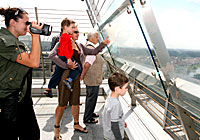
-
a tour of the Library involving the Book Museum
-
a tour Minsk at a Glance with a visit to the skydeck
-
excursions in the Book Museum
-
an excursion for kids Birthday in the Library
The tours cost:
-
Br1.30-Br8 per person
-
Br16.90 is the minimal cost for a group (up to 15 people)
Structure of the Library
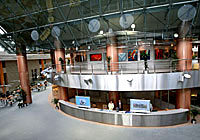 The space of the building is multifunctional and boasts modern equipment.
The space of the building is multifunctional and boasts modern equipment.
The total area of the building is 113,669m2 or one fourth of the Vatican territory. The building weighs 140,000 tonnes, roughly 14 times as much as the Eiffel Tower (about 270,000 tonnes with books and equipment).
The Library comprises:
-
20 reading halls (seats for 2,000, over 1,500 computerized seats)
-
the storage facility (designed to store 14 million units or 14% of Belarus’ total book collection)
-
the sociocultural center
-
the center for international meetings and negotiations (the Oval Room and the Round Room, an international press center, an office of the Belarus President)
-
departments (services for visitors, compilation of information resources, scientific and publishing activities)
-
engineering and technical services
The sociocultural center comprises:
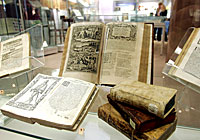
-
a conference hall (490 seats)
-
a complex of art galleries (Atrium, Labyrinth, Perspective, Panorama, Mobile Gallery)
-
the Book Museum (over 300 unique manuscripts and early printed books, including the Bibles (1517–1519) printed by the Belarusian printing pioneer Frantsisk Skorina)
-
a sport and recreation complex
-
a playroom for children
-
recreation zones
-
a restaurant and three cafes
-
an open-air skydeck and an indoors skydeck
As a unique feature of the architectural design the book storage facility is located in the upper part of the building for the sake of waterproofing and enabling comfortable conditions for the books.
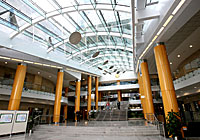 On the first floor you can find the information and registration desk, a tour office in the entrance hall.
On the first floor you can find the information and registration desk, a tour office in the entrance hall.
The Library has special workstations for blind people and visually handicapped people, people with physical disabilities.
The open-air skydeck is worth mentioning. It is located 73m above the ground in the upper part of the Library’s book storage facility. Over there visitors can admire the view of the Belarusian capital and take a look at remote locations using a panoramic binocular.
Modern technologies
The National Library of Belarus is a fine specimen of a smart building that boasts modern informational, technological, and engineering systems.
The new automated library system and software offers a number of convenient options to users:
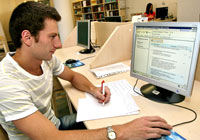
-
a digital directory
-
search for documents using multiple parameters
-
automated order and release of documents
-
free access to digital resources (proprietary databases, databases from internationally recognized manufacturers, bibliographic and full-text editions on compact disks)
-
an automated system to deliver books from the storage facility using special lifts (20 minutes as the world’s fastest book delivery)
-
remote access to the Library (a virtual reading hall)
The building implements the thermos flask principle, keeping the air temperature inside constant. Technological corridors along the walls represent a layer that prevents fluctuations of temperatures.
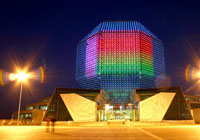 The Library is powered by three substations and two transformers. Even in an emergency they will keep the lights and video cameras on in the VIP zone and in the Office of the Belarus President.
The Library is powered by three substations and two transformers. Even in an emergency they will keep the lights and video cameras on in the VIP zone and in the Office of the Belarus President.
In the evening the building’s façade is converted into a multicolored LED screen consisting of over 4,500 light sources. It can produce over 20 light effect schemes using over 65,000 colors. It is the country’s largest means of advertising – 1,485m2.
Modern security and guard solutions have been implemented in the National Library.
Belarus Library in international rankings
-
11th in the fantastic architectural works ranking by the US edition Flavorwire (2013)
-
mentioned by the book 100 Most Surprising Achievements of Modern Architecture (by Yevgeniya Frolova, Russia, 2011) alongside internationally recognized works by Antoni Gaudi in Spain and the world’s highest building in the UAE
-
24th in the world’s top 50 unusual buildings according to the website Village of Joy
-
mentioned by the Berlin edition The World’s Best Libraries
How to get to the National Library
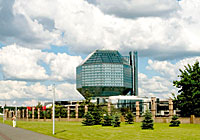 The National Library is located on the city’s central thoroughfare in Minsk’s northeast at 116 Nezavisimosti Avenue.
The National Library is located on the city’s central thoroughfare in Minsk’s northeast at 116 Nezavisimosti Avenue.
The fastest way to get to the National Library is using the Minsk metro to get to the Vostok station (the first line). You can also use ground means of transportation: buses and trolleybuses to get to the stops Natsionalnaya Biblioteka or Ulitsa Filimonova.


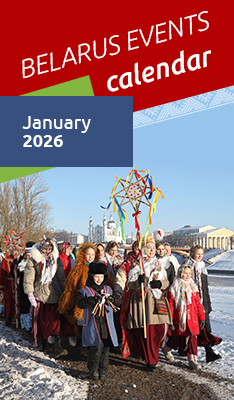




 print version
print version make home page
make home page add to bookmarks
add to bookmarks